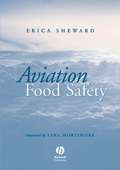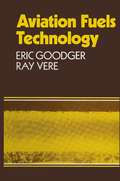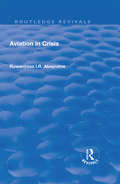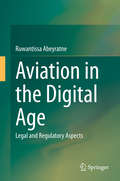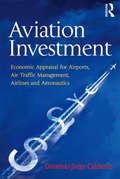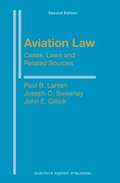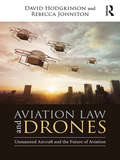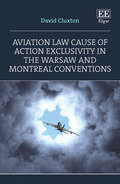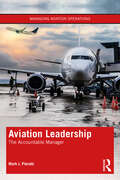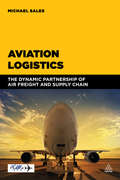- Table View
- List View
Aviation English: A lingua franca for pilots and air traffic controllers (Routledge Research in English for Specific Purposes)
by Dominique Estival Candace Farris Brett MolesworthAviation English investigates the key issues related to the use of English for the purpose of communication in aviation and analyses the current research on language training, testing and assessment in the area of Aviation English. Based on a series of recent empirical studies in aviation communication and taking an interdisciplinary approach, this book: provides a description of Aviation English from a linguistic perspective lays the foundation for increased focus in the area of Aviation English and its assessment in the form of English Language Proficiency (ELP) tests critically assesses recent empirical research in the domain. This book makes an important contribution to the development of the field of Aviation English and will be of interest to researchers in the areas of applied linguistics, TESOL and English for Specific Purposes.
Aviation Food Safety
by Erica ShewardThe provision of safe food to airline passengers is now a multi-billion dollar industry worldwide. As the aviation industry continues to grow year on year, so do passenger food service expectations, with increasing demand for wider choice and greater quality. Often neglected and under-regulated, food safety should be of paramount importance amid this growth. The consequences of in-flight food poisoning are extremely serious not only for the passengers involved, but also for the crew associated safety of the aircraft, and ultimately the airline’s reputation. In this much needed book Erica Sheward makes a compelling case for better management of food safety for all aspects of the aircraft food supply chain with comprehensive coverage of: HACCP Codes of practice Supply chain logistics Fitness to fly Managing aircraft water safety Liability issues Food Security Manufacturers and suppliers of products to the airline catering industry, business aviation caterers, airline Quality Assurance and hygiene personnel, product development managers, food safety regulators, aviation safety and security regulators, decision makers and company executives in any area of aviation as well as lecturers and students in all areas of the hospitality and travel sectors will find this book a vital tool.
Aviation in Crisis
by Ruwantissa AbeyratneThis title was first published in 2003. The events of 11 September 2001 defy modern economic theory when addressed in aviation terms. Economic theory would suggest that, once the impact of such events are a thing of the past, and economies are restored to their status quo ante, a rise in the gross domestic product of States to earlier levels would almost inevitably result in increased consumption. This in turn would mean that the demand for air travel would rise to earlier proportions and consumption in terms of air transport services would be restored to normalcy. However, the September attacks on United States' property introduced a unique characteristic through the fear factor that directly impacts the future development of air transport. As a result, the grim task of restoration of passenger confidence stands in the way of economic revival of the air transport industry. Aviation was always in crisis. The air transport industry, even prior to 11 September 2001, although seemingly a glamorous, exciting and prosperous business, never enjoyed sustained periods of profitability. Even among the large carriers, a short bout of profitability would inevitably be followed by a period of downturn in real income. It is simply that this fluctuation in fortune is an ineluctable characteristic of air transport, whose fortunes are dictated by rigid regulation, competition and technological change. If a sustained analysis were to be made of air transport, plain economic theory would no longer be the exclusive discipline for consideration. Rather, all relevant factors have to be taken in context and emerging issues should be analyzed as possible threats to the economic well being of the air transport industry. This book addresses issues in a post-September 2001 context but also analyses issues past and present, with the intent of looking at the future. Four major areas are taken into consideration which were in crisis but are truly impacted by the events of September 2001. These areas relate to crises in the commercial, security, insurance and environmental protection fields. Of these the first and fourth areas are inextricably intertwined, as aircraft noise regulations in various States have a direct impact on aircraft financing, which in turn is linked to demand for air services. A drop in demand for air services would essentially mean that the demand for lease or purchase of new aircraft would drop. When this occurs, air transport enterprises would be more inclined to cut costs and therefore concentrate on using the aircraft already at hand, upgrading them to conform to the The purpose of this book is to view the overall picture of an aviation industry - comprising air transport and other aviation related industries - in crisis, through issues that continue to impact the economic viability of air transport, particularly as a result of the events of 11 September 2001.
Aviation in Crisis
by Ruwantissa AbeyratneThis title was first published in 2003. The events of 11 September 2001 defy modern economic theory when addressed in aviation terms. Economic theory would suggest that, once the impact of such events are a thing of the past, and economies are restored to their status quo ante, a rise in the gross domestic product of States to earlier levels would almost inevitably result in increased consumption. This in turn would mean that the demand for air travel would rise to earlier proportions and consumption in terms of air transport services would be restored to normalcy. However, the September attacks on United States' property introduced a unique characteristic through the fear factor that directly impacts the future development of air transport. As a result, the grim task of restoration of passenger confidence stands in the way of economic revival of the air transport industry. Aviation was always in crisis. The air transport industry, even prior to 11 September 2001, although seemingly a glamorous, exciting and prosperous business, never enjoyed sustained periods of profitability. Even among the large carriers, a short bout of profitability would inevitably be followed by a period of downturn in real income. It is simply that this fluctuation in fortune is an ineluctable characteristic of air transport, whose fortunes are dictated by rigid regulation, competition and technological change. If a sustained analysis were to be made of air transport, plain economic theory would no longer be the exclusive discipline for consideration. Rather, all relevant factors have to be taken in context and emerging issues should be analyzed as possible threats to the economic well being of the air transport industry. This book addresses issues in a post-September 2001 context but also analyses issues past and present, with the intent of looking at the future. Four major areas are taken into consideration which were in crisis but are truly impacted by the events of September 2001. These areas relate to crises in the commercial, security, insurance and environmental protection fields. Of these the first and fourth areas are inextricably intertwined, as aircraft noise regulations in various States have a direct impact on aircraft financing, which in turn is linked to demand for air services. A drop in demand for air services would essentially mean that the demand for lease or purchase of new aircraft would drop. When this occurs, air transport enterprises would be more inclined to cut costs and therefore concentrate on using the aircraft already at hand, upgrading them to conform to the The purpose of this book is to view the overall picture of an aviation industry - comprising air transport and other aviation related industries - in crisis, through issues that continue to impact the economic viability of air transport, particularly as a result of the events of 11 September 2001.
Aviation in the Digital Age: Legal and Regulatory Aspects
by Ruwantissa AbeyratneAll of the topics discussed in this book – from sovereignty to cybercrime, and from drones to the identification of passengers & privacy – are profoundly affected by algorithms; so are air traffic services and aeronautical communications. All of these aviation-related aspects are addressed in a 75-year-old treaty called the Chicago Convention and its Annexes, which, as this book argues, needs to be reviewed with a focus on its relevance and applicability in connection with Moore’s Law, which posits that transistors in computer microchips double in speed, power and performance every two years, while the cost of computers is halved during the same period. Firstly, in terms of traditional territorial sovereignty, we have arrived at a point where there is a concept of data sovereignty and ownership that raises issues of privacy. Data transmission becomes ambivalent in terms of territorial sovereignty, and the Westphalian model may not be the perfect answer. Whether it be the manufacture of airplanes, the transfer of data on individuals, or the transmission of aeronautical and telecommunications information – all have to be carried out in accordance with the same fundamental principle: duty of care. Against the backdrop of the relevant provisions of the Chicago Convention and its Annexes, the detailed analysis presented here covers key areas such as: megatrends; AI and international law in the digital age; blockchain and aviation; drones; aviation and telecommunications; aviation and the Internet; cybersecurity; and digital identification of passengers & privacy. In turn, the book suggests how we can best manage this transition.
Aviation in the Literature and Culture of Interwar Britain (Studies in Mobilities, Literature, and Culture)
by Luke Seaber Michael McCluskeyAviation in the Literature and Culture of Interwar Britain looks at the impact of aviation in Britain and beyond through the 1920s and 1930s. This book considers how in this period flying went from a weapon of war to an extensive industry that included civilian air travel, air mail delivery, flying shows and campaigns to create ‘airmindedness’. Essays look at these developments through the work of writers, filmmakers and flyers and examines the airminded modernism that marked this radical period. Its fourteen chapters include studies of texts by Virginia Woolf, George Orwell, Elizabeth Bowen, W.H. Auden, T.H. White and John Masefield; accounts of the annual RAF Display at Hendon and the Schneider Trophy; and the achievements of celebrity flyers such as Amy Johnson. This collection provides a fresh perspective on the interwar period by bringing analysis of aviation and airmindedness to the study of British literature, history, modernism, mobilities and the history of technology and transportation.
Aviation Information Management: From Documents to Data
by Barbara G. KankiOperational information management is at a crossroads as it sheds the remaining vestiges of its paper-based processes and moves through the uncharted domain of electronic data processes. The final outcome is not yet in full focus, but real progress has been made in the transition to electronic documents providing the aviation industry with a clear direction. This book looks at a combination of industry initiatives and airline successes that point to the next steps that operators can take as they transition to fully integrated information management systems. Although the route has not been fully identified, it is evident that a key to successful long-term efficient information management is industry-wide cooperation. The chapters are authored by a range of experts in operational information management, and collectively, they outline ways that operators can improve efficiency across flight, ground and maintenance operations. Considerations and recommendations are identified and presented addressing the following priorities: Safety-critical information and procedures Human factors Information security Operational information standardization. The readership includes: Airline flight operations managers and standards personnel, Airline operating documents and publication specialists, Airline information managers, Commercial pilots, Airline maintenance managers and personnel, Manufacturers and vendors of aviation products, Aviation regulators and policy makers, Aviation researchers and developers of information technologies, and Military technical publications specialists.
Aviation Information Management: From Documents to Data
by Barbara G. KankiOperational information management is at a crossroads as it sheds the remaining vestiges of its paper-based processes and moves through the uncharted domain of electronic data processes. The final outcome is not yet in full focus, but real progress has been made in the transition to electronic documents providing the aviation industry with a clear direction. This book looks at a combination of industry initiatives and airline successes that point to the next steps that operators can take as they transition to fully integrated information management systems. Although the route has not been fully identified, it is evident that a key to successful long-term efficient information management is industry-wide cooperation. The chapters are authored by a range of experts in operational information management, and collectively, they outline ways that operators can improve efficiency across flight, ground and maintenance operations. Considerations and recommendations are identified and presented addressing the following priorities: Safety-critical information and procedures Human factors Information security Operational information standardization. The readership includes: Airline flight operations managers and standards personnel, Airline operating documents and publication specialists, Airline information managers, Commercial pilots, Airline maintenance managers and personnel, Manufacturers and vendors of aviation products, Aviation regulators and policy makers, Aviation researchers and developers of information technologies, and Military technical publications specialists.
Aviation Instruction and Training (Routledge Revivals)
by Ross A. TelferFirst published in 1993. In both general aviation and airline transport there is evidence of an emergent awareness of the importance of instruction in training. The demands of technological change, growing need for pilots at a time when the pool of experienced applicants is diminishing, and growing recognition of the importance of Human Factors to aviation safety, are straining the ability to cope. There is a growing recognition by management, of the contribution of ground and airborne instruction to the efficient operation of aviation in a variety of contexts. This book shows how professionals in the aviation industry and academic researchers complement each other in their pursuit of more effective and efficient flight training and instruction. Theory and practice each have a contribution to make. The contributions are thus drawn from regulatory authorities, airlines, universities, colleges, flying schools, the armed services and private practice. Such a mix brings differences in approach, style and argument showing both the variety and common aims in the emerging profession of flight instruction.
Aviation Instruction and Training (Routledge Revivals)
by Ross A. TelferFirst published in 1993. In both general aviation and airline transport there is evidence of an emergent awareness of the importance of instruction in training. The demands of technological change, growing need for pilots at a time when the pool of experienced applicants is diminishing, and growing recognition of the importance of Human Factors to aviation safety, are straining the ability to cope. There is a growing recognition by management, of the contribution of ground and airborne instruction to the efficient operation of aviation in a variety of contexts. This book shows how professionals in the aviation industry and academic researchers complement each other in their pursuit of more effective and efficient flight training and instruction. Theory and practice each have a contribution to make. The contributions are thus drawn from regulatory authorities, airlines, universities, colleges, flying schools, the armed services and private practice. Such a mix brings differences in approach, style and argument showing both the variety and common aims in the emerging profession of flight instruction.
Aviation Investment: Economic Appraisal for Airports, Air Traffic Management, Airlines and Aeronautics
by Doramas Jorge-CalderonAviation Investment uniquely addresses investment appraisal methods across the key industries that make up the aviation sector, including the airports, air traffic management, airline and aircraft manufacturing - or aeronautic - industries. It is a practice-oriented book where methods are presented through realistic case studies. The emphasis is on economic appraisal, or cost-benefit analysis, in order to determine the viability of projects not only for private investors but for society as a whole. Financial (cash flow) appraisal is illustrated alongside economic appraisal, as the latter builds on the former, but also to show how economic appraisal enhances standard financial appraisal to determine the long-term sustainability of any investment. Aviation is a capital-intensive sector that is growing rapidly, with world traffic expected to double over the next 15 years or so. A great deal of economic appraisal of investment projects takes place already, as aviation is subject to government intervention through economic regulation and financial support, and as both investors and policy makers seek to understand issues such as how environmental legislation may impact the viability of investments. Both economic growth and welfare go hand in hand with sound investment decisions, particularly regarding sectors such as aviation where investments are large and almost invariably debt-financed. Aviation Investment offers all aviation sub-sectors a single-source reference, bringing together the theoretical background of the economic appraisal literature and aviation investment in practice. It is written in a style that is accessible to non-academic professionals, using formulae only where strictly necessary to enable practical applications, and benefits from the substantial practical experience of the author.
Aviation Investment: Economic Appraisal for Airports, Air Traffic Management, Airlines and Aeronautics
by Doramas Jorge-CalderonAviation Investment uniquely addresses investment appraisal methods across the key industries that make up the aviation sector, including the airports, air traffic management, airline and aircraft manufacturing - or aeronautic - industries. It is a practice-oriented book where methods are presented through realistic case studies. The emphasis is on economic appraisal, or cost-benefit analysis, in order to determine the viability of projects not only for private investors but for society as a whole. Financial (cash flow) appraisal is illustrated alongside economic appraisal, as the latter builds on the former, but also to show how economic appraisal enhances standard financial appraisal to determine the long-term sustainability of any investment. Aviation is a capital-intensive sector that is growing rapidly, with world traffic expected to double over the next 15 years or so. A great deal of economic appraisal of investment projects takes place already, as aviation is subject to government intervention through economic regulation and financial support, and as both investors and policy makers seek to understand issues such as how environmental legislation may impact the viability of investments. Both economic growth and welfare go hand in hand with sound investment decisions, particularly regarding sectors such as aviation where investments are large and almost invariably debt-financed. Aviation Investment offers all aviation sub-sectors a single-source reference, bringing together the theoretical background of the economic appraisal literature and aviation investment in practice. It is written in a style that is accessible to non-academic professionals, using formulae only where strictly necessary to enable practical applications, and benefits from the substantial practical experience of the author.
Aviation Landmarks - Norfolk and Suffolk
by Peter B. GunnNorfolk and Suffolk are bursting with aviation heritage, having played key roles in military aviation through the two world wars and beyond. Notable landmarks include airfields past and present, traces of former radar stations, decoy airfields and other sites which were once highly secretive. Churches, memorials and museums provide abundant evidence, but less obvious connections are to be found in country houses, local pubs, streets and even village signs. All are explored in unprecedented detail by this knowledgeable local author. With illustrations, OS grid references and a full index, this definitive reference guide to the two counties, both in the air and on the ground, will delight interested locals and aviation enthusiasts alike.
Aviation Law: Cases, Laws And Related Sources
by Paul B. Larsen John E. Gillick Joseph C. SweeneyThe flying public, airlines, and governments will all agree on one date that changed commercial flying: that was September 11, 2001. The first edition of Aviation Law: Cases, Laws and Related Sources, described early consequences of that event, particularly compensation of victims and early tightening of aviation security. Subsequently laws and regulations affecting all aspects of aviation changed so rapidly that it became difficult to set a cut-off date for the second edition. The rapid flow of events made an update urgent.
Aviation Law and Drones: Unmanned Aircraft and the Future of Aviation
by David Hodgkinson Rebecca JohnstonThe aviation industry is being transformed by the use of unmanned aerial vehicles, or drones – commercially, militarily, scientifically and recreationally. National regulations have generally failed to keep pace with the expansion of the fast-growing drone industry. Aviation Law and Drones: Unmanned Aircraft and the Future of Aviation traces the development of aviation laws and regulations, explains how aviation is regulated at an international and national level, considers the interrelationship between rapidly advancing technology and legislative attempts to keep pace, and reviews existing domestic and international drone laws and issues (including safety, security, privacy and airspace issues). Against this background, the book uniquely proposes a rationale for, and key provisions of, guiding principles for the regulation of drones internationally – provisions of which could also be implemented domestically. Finally, the book examines the changing shape of our increasingly busy skies – technology beyond drones and the regulation of that technology. The world is on the edge of major disruption in aviation – drones are just the beginning. Given the almost universal interest in drones, this book will be of interest to readers worldwide, from the academic sector and beyond.
Aviation Law and Drones: Unmanned Aircraft and the Future of Aviation
by David Hodgkinson Rebecca JohnstonThe aviation industry is being transformed by the use of unmanned aerial vehicles, or drones – commercially, militarily, scientifically and recreationally. National regulations have generally failed to keep pace with the expansion of the fast-growing drone industry. Aviation Law and Drones: Unmanned Aircraft and the Future of Aviation traces the development of aviation laws and regulations, explains how aviation is regulated at an international and national level, considers the interrelationship between rapidly advancing technology and legislative attempts to keep pace, and reviews existing domestic and international drone laws and issues (including safety, security, privacy and airspace issues). Against this background, the book uniquely proposes a rationale for, and key provisions of, guiding principles for the regulation of drones internationally – provisions of which could also be implemented domestically. Finally, the book examines the changing shape of our increasingly busy skies – technology beyond drones and the regulation of that technology. The world is on the edge of major disruption in aviation – drones are just the beginning. Given the almost universal interest in drones, this book will be of interest to readers worldwide, from the academic sector and beyond.
Aviation Law Cause of Action Exclusivity in the Warsaw and Montreal Conventions
by David CluxtonThis incisive book tackles a controversy that has plagued the Warsaw Convention 1929 and the Montreal Convention 1999 for decades: whether the conventions provide an independent cause of action upon which a plaintiff can rely directly when pleading their action, and, if so, whether that cause of action provides the exclusive remedy. This book resolves this controversy by presenting a new conceptual framework for understanding aviation law cause of action in the conventions.Written in a scholarly yet engaging style, this insightful book reveals foundational concepts for the conventions’ regimes, from the legal relationships they govern, to the manner of their implementation in national law. Employing legal history and comparative law to support his arguments, David Cluxton enriches the doctrinal analysis with an in-depth academic study of the legal background to, and drafting history of, the Warsaw Convention, the subsequent development of the relevant issues, and the case law and commentary thereon.Aviation Law Cause of Action Exclusivity in the Warsaw and Montreal Conventions will be a valuable resource for scholars and students of private air law, private international law and dispute resolution, while also being of great interest to aviation law practitioners and aviation insurers and policy-makers.
Aviation Leadership: The Accountable Manager (Managing Aviation Operations)
by Mark J. PierottiThis book identifies the responsibilities of management in the regulatory territories of the FAA (USA), the EASA (European Union) and the GCAA (UAE), identifying the daily challenges of leadership in ensuring their company is meeting the regulatory obligations of compliance, safety and security that will satisfy the regulator while also meeting the fiducial responsibilities of running an economically viable and efficient lean company that will satisfy the shareholders. Detailing each responsibility of the Accountable Manager, the author breaks them down to understandable and achievable elements where methods, systems and techniques can be applied to ensure the role holder is knowledgeable of accountabilities and is confident that they are not only compliant with the civil aviation regulations but also running an efficient and effective operation. This includes the defining of an Accountable Manager "tool kit" as well as possible software "dashboards" that focus the Accountable Manager on the important analytics, such as the information and data available, as well as making the maximum use of their expert post holder team. This book will be of interest to leadership of all aviation- related companies, such as airlines, charter operators, private and executive operators, flying schools, aircraft and component maintenance facilities, aircraft manufacturers, engine manufacturers, component manufacturers, regulators, legal companies, leasing companies, banks and finance houses, departments of transport, etc; any relevant organisation regulated and licensed by civil aviation authority. It can also be used by students within a wide range of aviation courses at colleges, universities and training academies.
Aviation Leadership: The Accountable Manager (Managing Aviation Operations)
by Mark J. PierottiThis book identifies the responsibilities of management in the regulatory territories of the FAA (USA), the EASA (European Union) and the GCAA (UAE), identifying the daily challenges of leadership in ensuring their company is meeting the regulatory obligations of compliance, safety and security that will satisfy the regulator while also meeting the fiducial responsibilities of running an economically viable and efficient lean company that will satisfy the shareholders. Detailing each responsibility of the Accountable Manager, the author breaks them down to understandable and achievable elements where methods, systems and techniques can be applied to ensure the role holder is knowledgeable of accountabilities and is confident that they are not only compliant with the civil aviation regulations but also running an efficient and effective operation. This includes the defining of an Accountable Manager "tool kit" as well as possible software "dashboards" that focus the Accountable Manager on the important analytics, such as the information and data available, as well as making the maximum use of their expert post holder team. This book will be of interest to leadership of all aviation- related companies, such as airlines, charter operators, private and executive operators, flying schools, aircraft and component maintenance facilities, aircraft manufacturers, engine manufacturers, component manufacturers, regulators, legal companies, leasing companies, banks and finance houses, departments of transport, etc; any relevant organisation regulated and licensed by civil aviation authority. It can also be used by students within a wide range of aviation courses at colleges, universities and training academies.
Aviation Logistics: The Dynamic Partnership of Air Freight and Supply Chain
by Michael SalesAviation Logistics looks at the function of the air cargo business and its role in global supply chains and logistics. As global economies are constantly evolving, the supply chain business with its transport partners must be proactive for the future. Technology and its resulting efficiency and transparency are therefore a central part of this book. Aviation Logistics examines how carriers are coming up with new methods and technologies to improve ground handling and road transport, traceability systems and barcoding, security and screening, and safe delivery of perishable items (such as in the pharmaceutical and medical sectors). Endorsed by The International Air Cargo Association (TIACA), Aviation Logistics is supplemented with case studies and contributions from a team of experts including Oliver Evans and Stan Wraight, both industry experts.Online resources available: Air Cargo News' Freighter Directory.
Aviation Logistics: The Dynamic Partnership of Air Freight and Supply Chain
by Michael SalesAviation Logistics looks at the function of the air cargo business and its role in global supply chains and logistics. As global economies are constantly evolving, the supply chain business with its transport partners must be proactive for the future. Technology and its resulting efficiency and transparency are therefore a central part of this book. Aviation Logistics examines how carriers are coming up with new methods and technologies to improve ground handling and road transport, traceability systems and barcoding, security and screening, and safe delivery of perishable items (such as in the pharmaceutical and medical sectors). Endorsed by The International Air Cargo Association (TIACA), Aviation Logistics is supplemented with case studies and contributions from a team of experts including Oliver Evans and Stan Wraight, both industry experts.Online resources available: Air Cargo News' Freighter Directory.
Aviation Markets: Studies in Competition and Regulatory Reform
by David StarkieAviation Markets: Studies in Competition and Regulatory Reform is a collection of 17 papers selected from David Starkie's extensive writings over the last 25 years. Previously published material has been extensively edited and adapted, and combined with new material, published here for the first time. The book is divided into five sections, each featuring an original overview chapter, to better establish the background and also explain the papers' wider significance including, wherever appropriate, their relevance to current policy issues. These papers have been selected to illustrate a significant theme that has been relatively neglected thus far in both aviation and industrial economics: the role of the market and its interplay with the development of economic policy in the context of a dynamic but partly price regulated industry. The result provides a strong flavour of how market mechanisms, and particularly competition, can operate to successfully resolve policy issues. The book will be of interest to academics and those engaged in the formulation of aviation policy, such as public administrators and consultants, as well as those working in the aviation industry. It is also relevant to economic studies in a more general context, particularly to students and practitioners in industrial organisation economics, including those studying and researching the public utility industries.
Aviation Markets: Studies in Competition and Regulatory Reform
by David StarkieAviation Markets: Studies in Competition and Regulatory Reform is a collection of 17 papers selected from David Starkie's extensive writings over the last 25 years. Previously published material has been extensively edited and adapted, and combined with new material, published here for the first time. The book is divided into five sections, each featuring an original overview chapter, to better establish the background and also explain the papers' wider significance including, wherever appropriate, their relevance to current policy issues. These papers have been selected to illustrate a significant theme that has been relatively neglected thus far in both aviation and industrial economics: the role of the market and its interplay with the development of economic policy in the context of a dynamic but partly price regulated industry. The result provides a strong flavour of how market mechanisms, and particularly competition, can operate to successfully resolve policy issues. The book will be of interest to academics and those engaged in the formulation of aviation policy, such as public administrators and consultants, as well as those working in the aviation industry. It is also relevant to economic studies in a more general context, particularly to students and practitioners in industrial organisation economics, including those studying and researching the public utility industries.
Aviation Mental Health: Psychological Implications for Air Transportation
by Robert Bor Todd HubbardThis book provides an authoritative and practical guide to the assessment, management, treatment and care of pilots and other professional groups within aviation; covering a range of relevant topics, for health and human resources practitioners working in the airline industry. Pilot mental health has, hitherto, been regarded as a specialist topic in aviation medicine. Consequently, practitioners and researchers alike have been forced to consult specialist journals or seek out a relevant chapter on this topic in a general textbook to develop or update their understanding of the relevant issues. This book seeks to remedy this situation by gathering together all of the relevant insights into a single authoritative source gathered from the leading specialists in the field. It aims to cover all of the main relevant issues including the assessment, care, management and treatment of mental health problems, as well as the prevention of mental health problems among this occupational group.

